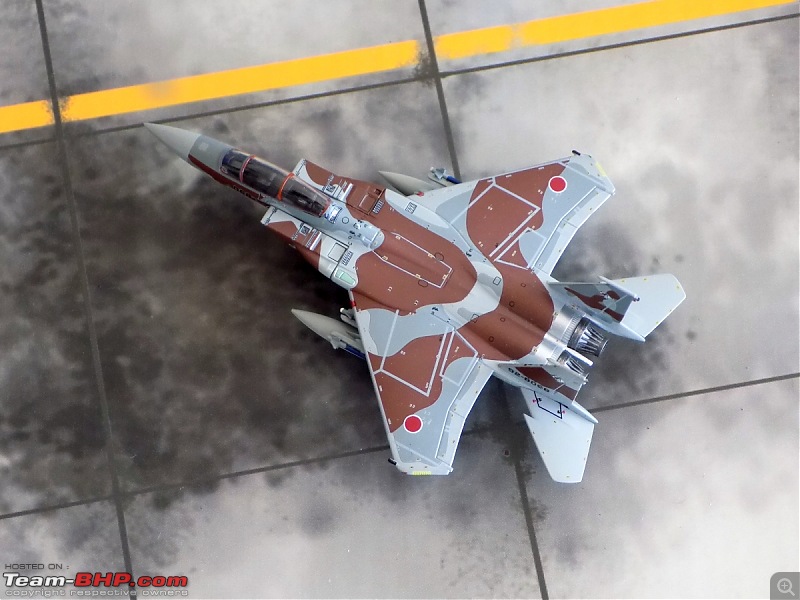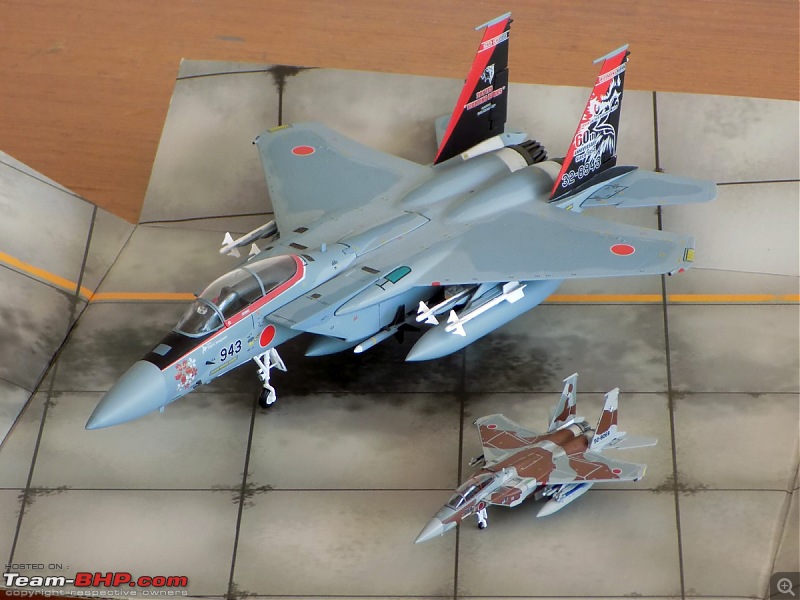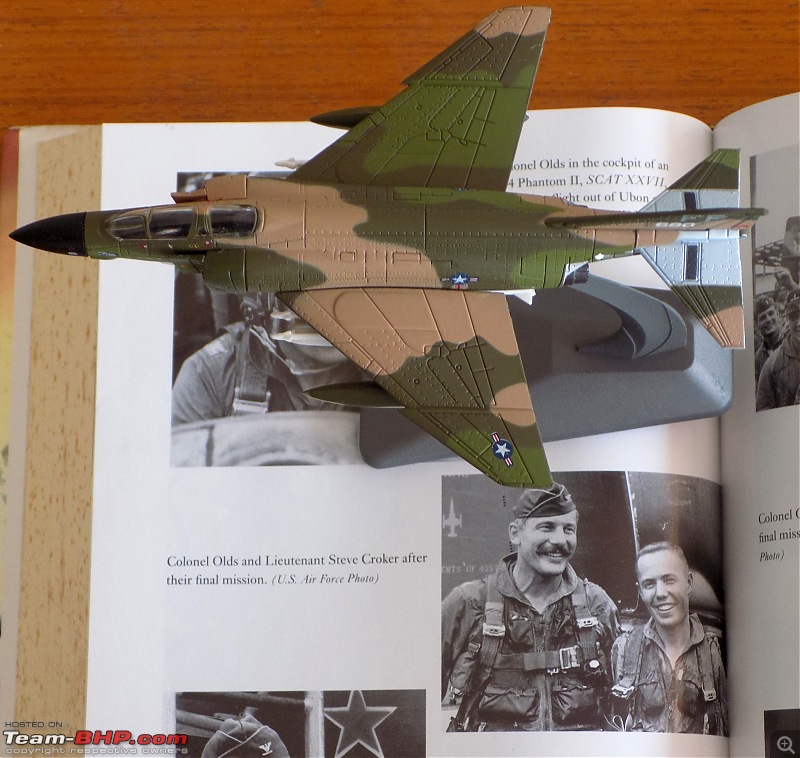Quote:
Originally Posted by V.Narayan  The ride of your favourite ace  the handsome Phantom F-4C. Congratulations. |
Thank You Sir. I am on the lookout for F-4J "Showtime 100" (US Navy aces Lt Driscoll and Lt Cunningham's F-4J) to my collection.
1:72 General Atomics MQ-1B Predator 99-057 USAF 432nd WG, Creech AFB, Nevada, USA (Air Force 1 Models) 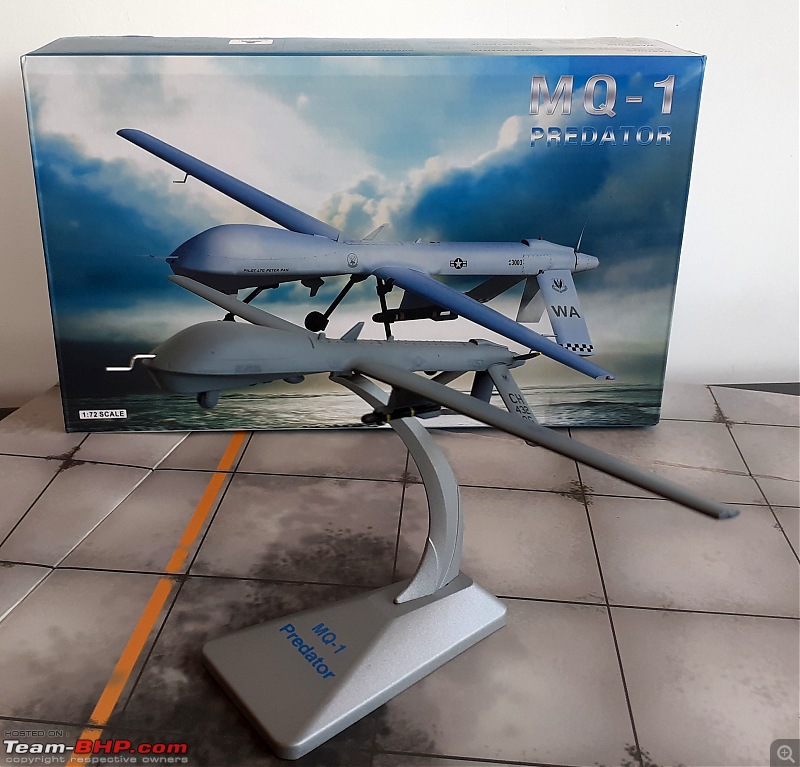
The General Atomics MQ-1 Predator is an American remotely piloted aircraft (RPA)/ Unmanned Aerial Vehicle (UAV) built by General Atomics that was used primarily by the United States Air Force (USAF) and Central Intelligence Agency (CIA). Initially conceived in the early 1990s for aerial reconnaissance and forward observation roles, the Predator carries cameras and other sensors. It was modified and upgraded to carry and fire two AGM-114 Hellfire missiles or other munitions. The aircraft entered service in 1995, and saw combat in the war in Afghanistan, Pakistan, the NATO intervention in Bosnia, Serbia, the Iraq War, Yemen, the 2011 Libyan civil war, the 2014 intervention in Syria, and Somalia.
At one point in time, when the MQ-1 was flying around unhindered over Pakistan(from 2003 to 2011), the Predator was mockingly referred to as the national bird of Pakistan!!!

An Iraqi MiG-25 shot down a MQ-1 Predator performing reconnaissance over the no fly zone in Iraq on 23 December 2002. This was the first time in history a conventional aircraft and a drone had engaged each other in combat. Predators had been armed with AIM-92 Stinger air-to-air missiles, and were purportedly being used to "bait" Iraqi Air Force fighters, then run. However, Predators are 1,800 mph slower than MIG-25's and the service ceiling is nearly 60,000 ft lower, making the "run" segment of any "bait and run" mission a difficult task. In this incident, the Predator did not run (or could not run fast enough), but instead fired one of its Stingers at the Iraqi Foxbat. The Stinger's heat-seeker became "distracted" by the MiG's missile and missed the MiG. The Predator was hit by the MiG's missile and destroyed. Another two Predators had been shot down earlier by Iraqi SAMs.
Two or three MQ-9B Sea Guardians - a larger, heavier, more capable and navalised derivative of the MQ-1 Predator; is currently on lease with the Indian Navy.



The basic crew for the Predator is one pilot and two sensor operators. They fly the aircraft from inside the ground control station via a line-of-sight data link or a satellite data link for beyond line-of-sight flight. The aircraft is equipped with a color nose camera (generally used by the pilot for flight control), a day variable-aperture TV camera, a variable-aperture infrared camera (for low light/night), and a synthetic aperture radar for looking through smoke, clouds or haze. The cameras produce full motion video while the SAR produces still frame radar images.
The MQ-1 Predator carries the Multi-spectral Targeting System with inherent AGM-114 Hellfire missile targeting capability and integrates electro-optical, infrared, laser designator and laser illuminator into a single sensor package. The aircraft can employ two laser-guided Hellfire anti-tank missiles with the MTS ball.
The system is composed of four major components which can be deployed for worldwide operations. The Predator aircraft can be disassembled and loaded into a "coffin." The ground control system is transportable in a C-130 (or larger) transport aircraft. The Predator can operate on a 5,000 by 75 feet (1,524 meters by 23 meters), hard surface runway with clear line-of-sight. The ground data terminal antenna provides line-of-sight communications for takeoff and landing. The PPSL provides over-the-horizon communications for the aircraft.
An alternate method of employment, Remote Split Operations, employs a smaller version of the GCS called the Launch and Recovery GCS. The LRGCS conducts takeoff and landing operations at the forward deployed location while the CONUS based GCS conducts the mission via extended communication links.
The aircraft includes an ARC-210 radio, an APX-100 IFF/SIF with Mode 4, an upgraded turbo-charged engine and glycol-weeping "wet wings" for ice mitigation. The latest upgrade, which enhances maintenance and performance, includes notched tails, split engine cowling, steel braided hoses and improved engine blocks.
The 432nd Wing is a United States Air Force unit assigned to Air Combat Command at Creech Air Force Base near Indian Springs, Nevada. The group operates unmanned reconnaissance aircraft which provide real-time reconnaissance, surveillance, and precision attack against fixed and time-critical targets. It currently flies General Atomics MQ-9 Reaper and RQ-170 Sentinel Unmanned aerial vehicles.
General Characteristics
-Primary Function: Armed reconnaissance, airborne surveillance and target acquisition
-Contractor: General Atomics Aeronautical Systems Incorporated
-Crew (remote): Two (pilot and sensor operator)
-Length: 27 ft (8.22 m)
-Wingspan: 48.7 ft (14.8 m); MQ-1B Block 10/15: 55.25 ft (16.84 m)
-Height: 6.9 ft (2.1 m)
-Wing area: 123.3 sq ft (11.5 m˛)
-Empty weight: 1,130 lb (512 kg)
-Loaded weight: 2,250 lb (1,020 kg)
-Power plant: 1 ×Rotax 914 F turbocharged four-cylinder engine, 115 hp (86 kW)
Performance
-Maximum speed: 135 mph (117 knots, 217 km/h)
-Cruise speed: 81–103 mph (70–90 knots, 130–165 km/h)
-Thrust: 115 horsepower
-Stall speed: 62 mph (54 knots, 100 km/h) (dependent on aircraft weight)
-Range: 675 nmi (675 mi or 1,100 km)
-Max. takeoff weight: 2,250 lb (1,020 kg)
-Payload: 450 pounds (204 kilograms)
-Ceiling: up to 25,000 feet (7,620 meters)
-Endurance: 24 hours
-Armament: 2 with provisions to carry combinations of Missiles:
2 × AGM-114 Hellfire
4 × AIM-92 Stinger air to air missiles
6 × AGM-176 Griffin air-to-surface missiles
-Fuel Capacity: 665 pounds (100 gallons)
-Service ceiling: 25,000 ft (7,620 m)
The model can be displayed "Inflight" or "On ground" with interchangeable attachments for the landing gear. The model is armed with Two AGM-114 Hellfires.

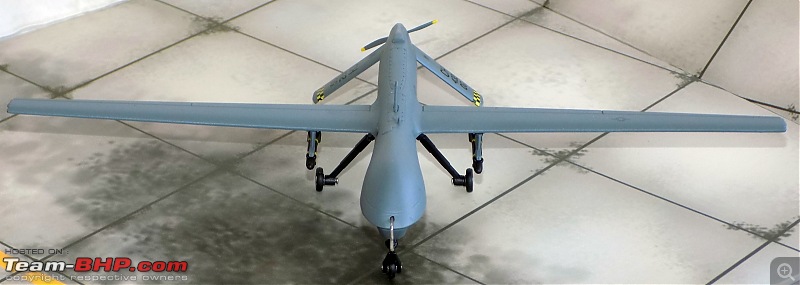
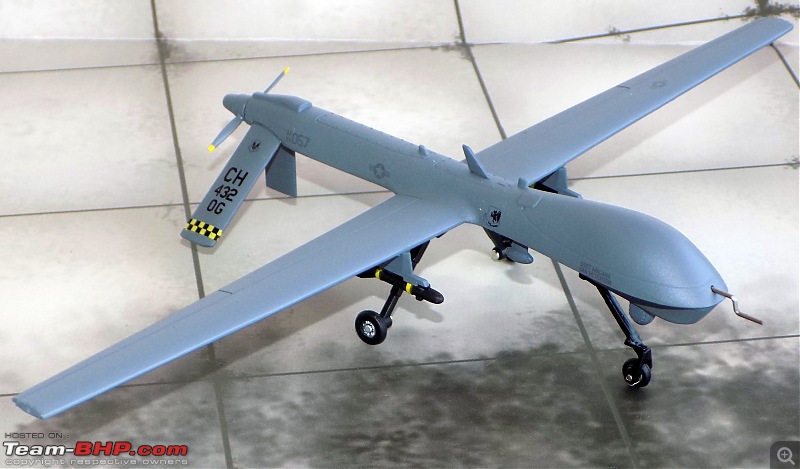

The crew names -Staff sergeant (SSgt) Magana & Senior Airman (SRA) Peterson







In-Flight

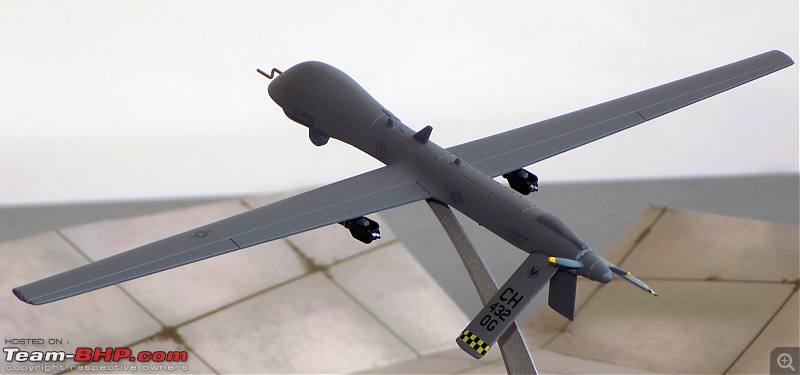




Comparison with the F-16's wingspan. The F-16s's wingspan is 9.96 m while the Predator's is 14.8 m.



 (1)
Thanks
(1)
Thanks
 (3)
Thanks
(3)
Thanks

 (1)
Thanks
(1)
Thanks
 (3)
Thanks
(3)
Thanks
 (11)
Thanks
(11)
Thanks
 (1)
Thanks
(1)
Thanks

 (2)
Thanks
(2)
Thanks
 (2)
Thanks
(2)
Thanks
 (1)
Thanks
(1)
Thanks

 (4)
Thanks
(4)
Thanks
 (3)
Thanks
(3)
Thanks
 (8)
Thanks
(8)
Thanks

 (2)
Thanks
(2)
Thanks
 (3)
Thanks
(3)
Thanks
 (1)
Thanks
(1)
Thanks





 Unfortunately like many advance weapons systems in development during the collapse of the USSR this too never made it to production.
Unfortunately like many advance weapons systems in development during the collapse of the USSR this too never made it to production.

 .
.















 .
. 




 Congratulations. That is one big job out of the way. That is quite a Wing you have there. Looking first class. Here's to many more
Congratulations. That is one big job out of the way. That is quite a Wing you have there. Looking first class. Here's to many more Your daughters' contributions are too cute. I am working on a two year project to convince wifey that I need a new cabinet {my fourth} The unwritten rule is that my study is mine, rest is hers. But as I said it is a two year project 23 months to woo her around and 1 month to execute :-)
Your daughters' contributions are too cute. I am working on a two year project to convince wifey that I need a new cabinet {my fourth} The unwritten rule is that my study is mine, rest is hers. But as I said it is a two year project 23 months to woo her around and 1 month to execute :-)





